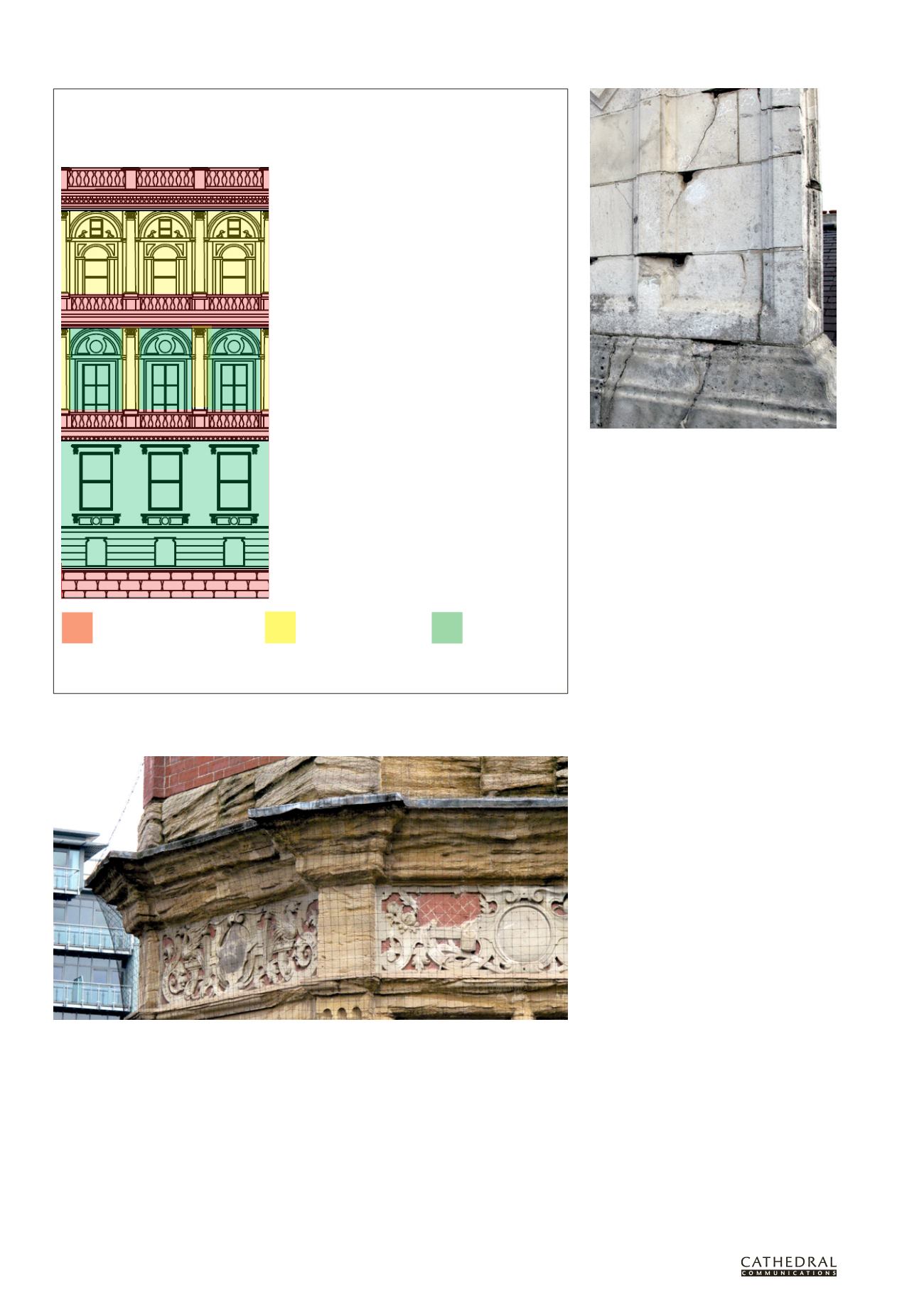

1 5 2
T H E B U I L D I N G C O N S E R VAT I O N D I R E C T O R Y 2 0 1 5
T W E N T Y S E C O N D E D I T I O N
SERV I CES & TREATMENT :
PROTEC T I ON & REMED I AL TREATMENT
4.1
first. Secondly, repairs made to a moderately
to heavily soiled surface can be highly
conspicuous – a patchwork of light blocks
set within a dark ground. Indeed, even where
stonework has been cleaned, repairs in new
(matching) stone may appear lighter in colour
next to weathered, historic stone which will
have its own patina.
Relative degrees of exposure and weathering: exposure is a key criterion for scheduling and specifying
individual repair methods and materials. Stone in the red zones typically exhibits a greater degree of
weathering and deterioration. To be durable and effective, repairs must be designed to suit the exposure.
Understanding the weathering characteristics of natural building stone is an essential part of survey work.
Weathering has accentuated the natural bedding planes of the limestone and eroded the softer beds of this
late-19th century masonry. Progressive decay is especially problematic in the case of projecting elements where
there is an increased risk of failure and detachment of fragments.
Corroding ferrous metal cramps can cause
considerable damage in the form of cracking and
spalling, as visible in this Portland stone chimney
where extensive stone indents are now required.
Typically a pre-cleaning inspection
is carried out as soon as scaffold access is
available. This is a general assessment to check
for potential problems such as open joints
and fractures that may admit water during
wet cleaning work. Detailed survey normally
proceeds after masonry cleaning so that all
defects are readily identifiable.
Responsibility for inspection, scheduling
and documentation should be clearly set
out in the contract documents. All survey
work should be carried out by specialists
experienced in the conservation and repair of
decorative masonry, and the detailed survey
and condition assessment is best carried out
by the contractor and specifier jointly, as this
has a number of advantages: repairs can be
agreed and measured more quickly, unusual
or difficult repair issues can be resolved
jointly, and minor intrusive investigation to
understand the extent or nature of defects
can be carried out immediately. Contract
documents should set out the criteria for stone
repair and replacement (discussed below).
COMMON DEFECTS, BUILDING
STONES AND REPAIR TYPES
Stone masonry defects should be assessed
individually and repairs tailored to suit the
exposure and the building element. This is
especially important for elaborately detailed
buildings with decorative mouldings and
projections such as cornices.
Repair types commonly include:
• stone indents or ‘piecing-in’ repairs
• mortar or ‘plastic’ repairs
• the installation or repair of
existing lead weatherings
Stone indents can be designed to suit all
conditions, but mortar repairs are sometimes
more practical, particularly for smaller defects
or in sheltered areas. However, as a general
rule, mortar repairs will not be sufficiently
durable for repair work on severe exposures
(unprotected copings, cornices, ledges, other
projecting mouldings/elements) although they
may be suitable in more sheltered locations
(with reinforcement, depending on the size
and location) and can be used if necessary
at ground level where their condition can be
more easily monitored and they can be more
readily renewed.
Repair and replacement stone should be of
matching type. If the original stone is no longer
KEY
Severe Exposure
Most susceptible to rainwater
saturation, frost, organic
growth, and soiling. All mortar
joints are vulnerable to erosion
and should be inspected.
Moderate Exposure
Subject to rain and
weather, but less risk
of saturation, frost,
organic growth and
other soiling
Sheltered
Recessed or
protected areas,
less exposed to
direct rain and
wind
Where appropriate lead protection can be used for
severe exposures – cornices/copings/hood moulds
CONDITION SURVEY
Assessment of weathering and exposure to inform
masonry repair work
Severe exposure – roof level chimneys, balustrades,
and weatherings, including any sky facing surfaces
and projections such as cornices and copings
Ground level plinth – vulnerable zone due to cycles of
wetting + drying, evaporation, and salt crystallisation
Elaborate, projecting mouldings and window
balcony balustrades
Vulnerable cornice projections with saddle joints
designed to shed rainwater
D
D
D
D
















